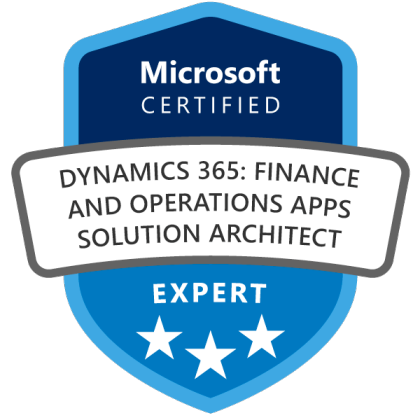MB-700: Microsoft Dynamics 365: Finance and Operations Apps Solution Architect
Welcome to the MB-700: Microsoft Dynamics 365: Finance and Operations Apps Solution Architect course! This course is designed for those who aspire to be solution architects and are new to the solution architect role.This course will cover technical information that focuses on application architecture and the technical skills you will need to start your journey into the role of solution architect. The activities within this course MB-700: Microsoft Dynamics 365: Finance and Operations Apps Solution Architect are not based on guided labs and technology environments. Instead the activities are designed to engage you in real scenarios and challenges the solution architect will encounter during their implementation. The goal is to better prepare you for the solution architect role.The audience for this course should have experience with functional and/or technical focus in Dynamics 365 Finance and Operations appl. The course is designed primarily for those who are new to the solution architect role.
Microsoft Courseware
Instructor-Led Training
Course Duration: 4-Days (32-Hour)
Microsoft Official Lab Exercises
Courseware Life Time Free Upgrade
Cloud Lab Access
Overview
The Solution Architect leads successful implementations and focuses on how solutions address the broader business and technical needs of organizations. This module covers what it takes to get started as a Solution Architect and as key member of the overall project team.
With proper planning, your finance and operations apps implementation will be a success. After a customer signs the agreements to purchase licenses for finance and operations apps, your job as a functional consultant starts by managing the application lifecycle and moving toward predictable, repeatable, high-quality implementation.Learn how to prepare data for migration, by using the data management framework to manage data entities and data entity packages in finance and operations apps.
Modules
Module 1: The Solution Architect Role
- The Solution Architect Role
Module 2: Manage interactions with FastTrack
- Get to know FastTrack
Module 3: Solution blueprint
- Solution blueprint definition and components
- Project governance and timelines
- Solution architecture and organizational structure
- Working with business process catalog
Module 4: Define environments tools and deployment strategy
- Set up Inventory
- Configure sales pricing and discounts
Module 5: Determine data management strategy
- Data management overview
- Develop data migration strategy
Module 6: Determine integration and interfaces strategies
- Develop integration strategy
- Integration options
Module 7: Define security architecture
- Important security aspects
- Security framework
- Define security strategy
Module 8: Define a testing strategy
- Testing strategy overview
- Testing planning and execution
Module 9: Define performance testing strategy
- Prepare for performance topics
- Utilize performance testing tools
Module 10: Business intelligence and reporting
- Implement business intelligence and reporting
Module 11: Determine licensing and support
- Understand licensing estimation
- Understand support options
Module 12: Prepare for go-live
- Complete solution blueprint
- Prepare for go-live
Fees And Schedule
Instructor-Led Training
32-Hour of Instructor-Led Training One to one doubt resolution sessions Microsoft Official Lab AccessLearning Objectives
At the end of this course, students should be able to:
- Learn about what is expected of a solution architect.
- Learn about the role of a solution architect during the project phases.
- Learn how to ask customers questions about their business processes and feature requirements to create a viable solution.
- Learn how to propose a solution.
- Learn how to capture requirements and identify functional and non-functional items.
- Categorize business requirements and perform a fit gap analysis.
- Refine requirements from proof of concept insights.
- Understand the functionality and tools of Lifecycle Services for finance and operations apps
- Identify and analyze gaps using the Business Process Modeler
- Learn how to participate in the creation of Business requirement documents (BRD).
- Learn about the functionality and features of Dynamics 365 Translation Service.
Reviews

Dipak Agarwal - Business Analyst at Genpact
Excellent professional & comfortable environment to learn
The training was good, I would like to go through some more training.

Gurpreet Marwaha - IAM Analyst at National Australia Bank, Australia
I learned a lot
Excellent Office 365 training provided by Flexmind
Kiranmai Yachareni - Web Developer at Total Quality Logistics, USA
Excellent ability to clarify all the queries I raised
Thank You! I would definitely recommend it to others. The training session was very informative and interactive. Very useful and definitely thought-provoking. All the module sessions were clear and interactive, great, and friendly. Catered to all levels, which was good for those just starting out and those with more experience. I really appreciate the recorded videos and training material, which would be definitely helpful for later references.

Praveen S (Associate at Grant Thornton LLP)
Excellent knowledge of the trainer on the Subject
I attended PowerApps/Flow training from Flexmind. The topics of the course were well organized & knowledge of the trainer on the subject was excellent. It was very helpful and I will apply in my day to day task at the office. I will definitely recommend a friend or colleague to attend courses from Flexmind.
